
Illustrative Math Alignment: Grade 6 Unit 9
Putting it All Together
Lesson 4: How Do We Choose?
Use the following Media4Math resources with this Illustrative Math lesson.
| Thumbnail Image | Title | Body | Curriculum Topics |
|---|---|---|---|

|
Algebra Nspirations Teacher's Guide: Quadratic Functions | Algebra Nspirations Teacher's Guide: Quadratic Functions
This is the Teacher's Guide that accompanies Algebra Nspirations: Quadratic Functions. This is part of a collection of teacher's guides. To see the complete collection of teacher's guides, click on this link. Note: The download is a PDF file.Related ResourcesTo see resources related to this topic click on the Related Resources tab above. |
Applications of Quadratic Functions |

|
Algebra Nspirations Teacher's Guide: Variables and Equations | Algebra Nspirations Teacher's Guide: Variables and Equations
This is the Teacher's Guide that accompanies Algebra Nspirations: Variables and Equations. This is part of a collection of teacher's guides. To see the complete collection of teacher's guides, click on this link. Note: The download is a PDF file.Related ResourcesTo see resources related to this topic click on the Related Resources tab above. |
Applications of Equations and Inequalities |

|
Algebra Nspirations Teacher's Guide: Inequalities | Algebra Nspirations Teacher's Guide: Inequalities
This is the Teacher's Guide that accompanies Algebra Nspirations: Inequalities. This is part of a collection of teacher's guides. To see the complete collection of teacher's guides, click on this link. Note: The download is a PDF file.Related ResourcesTo see resources related to this topic click on the Related Resources tab above. |
Applications of Equations and Inequalities |

|
Algebra Nspirations Teacher's Guide: Functions and Relations | Algebra Nspirations Teacher's Guide: Functions and Relations
This is the Teacher's Guide that accompanies Algebra Nspirations: Functions and Relations. This is part of a collection of teacher's guides. To see the complete collection of teacher's guides, click on this link. Note: The download is a PDF file.Related ResourcesTo see resources related to this topic click on the Related Resources tab above. |
Applications of Functions and Relations |
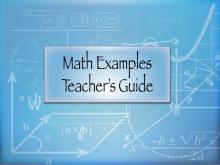
|
MATH EXAMPLES--Teacher's Guide: Graphs of Rational Functions | MATH EXAMPLES--Teacher's Guide: Graphs of Rational Functions
This Teacher's Guide provides an overview of the 28 worked-out examples that show how to graph Rational Functions. This is part of a collection of teacher's guides. To see the complete collection of teacher's guides, click on this link. Note: The download is a PDF file.Related ResourcesTo see resources related to this topic click on the Related Resources tab above. |
Rational Functions and Equations |

|
MATH EXAMPLES--Teacher's Guide: Rational Expressions | MATH EXAMPLES--Teacher's Guide: Rational Expressions
This Teacher's Guide provides an overview of the 28 worked-out examples that show how to simplify a variety of rational expressions. This is part of a collection of teacher's guides. To see the complete collection of teacher's guides, click on this link. Note: The download is a PDF file.Related ResourcesTo see resources related to this topic click on the Related Resources tab above. |
Rational Expressions and Rational Functions and Equations |

|
Video Transcript: Algebra Applications: Linear Functions, Segment 3: Oil Exploration | Video Transcript: Algebra Applications: Linear Functions, Segment 3: Oil Exploration
Linear Expressions, Equations, and FunctionsLinear Expressio |
Applications of Linear Functions and Graphs of Linear Functions |

|
Video Transcript: Algebra Applications: Rational Functions | Video Transcript: Algebra Applications: Rational Functions
This is the transcript for the video of same title. Video contents: In this episode of Algebra Applications, students explore various scenarios that can be explained through the use of rational functions. Such disparate phenomena as submarines, photography, and the appearance of certain organisms can be explained through rational function models. |
Rational Expressions and Rational Functions and Equations |

|
Video Transcript: Algebra Applications: Rational Functions, Segment 1: Submarines | Video Transcript: Algebra Applications: Rational Functions, Segment 1: Submarines
This is the transcript for the video of same title. Video contents: In spite of their massive size, submarines are precision instruments. A submarine must withstand large amounts of water pressure; otherwise, a serious breach can occur. Rational functions are used to study the relationship between water pressure and volume. Students graph rational functions to study the forces at work with a submarine. |
Rational Expressions and Rational Functions and Equations |

|
Video Transcript: Algebra Applications: Rational Functions, Segment 2: Biology | Video Transcript: Algebra Applications: Rational Functions, Segment 2: Biology
This is the transcript for the video of same title. Video contents: All living things take up a certain amount of space, and therefore have volume. They also have a certain amount of surface area. The ratio of surface area to volume, which is a rational function, reveals important information about the organism. Students look at different graphs of these functions for different organisms. |
Rational Expressions and Rational Functions and Equations |

|
Video Transcript: Algebra Applications: Rational Functions, Segment 3: Hubble Telescope | Video Transcript: Algebra Applications: Rational Functions, Segment 3: Hubble Telescope
This is the transcript for the video of same title. Video contents: The Hubble Telescope has transformed how we view the universe. We learn about the lens formula and how it is used in the construction of telescopes. This is part of a collection of video transcript from the Algebra Applications video series. To see the complete collection of transcripts, click on this link. Note: The download is a PDF file. Video Transcript LibraryTo see the complete collection of video transcriptsy, click on this link. |
Rational Expressions and Rational Functions and Equations |

|
Video Transcript: Algebra Applications: Variables and Equations, Segment 3: River Ratios | Video Transcript: Algebra Applications: Variables and Equations, Segment 3: River Ratios This is the transcript for the video of same title. Video contents: Why do rivers meander instead of traveling in a straight line? In going from point A to point B, why should a river take the circuitous route it does instead of a direct path? Furthermore, what information can the ratio of the river's length to its straight-line distance tell us? In this segment the geological forces that account for a river's motion are explained. In the process, the so-called Meander Ratio is explored. Students construct a mathematical model of a meandering river using the TI-Nspire. Having built the model, students then use it to generate data to find the average of many Meander Ratios. The results show that on average the Meander Ratio is equal to pi. |
Applications of Equations and Inequalities and Applications of Ratios, Proportions, and Percents |

|
Video Transcript: Algebra Nspirations: Data Analysis and Probability | Video Transcript: Algebra Nspirations: Data Analysis and Probability
This is the transcript for the video of same title. Video contents: What are the two meanings of statistics? What does it really mean that an event has a 50% probability of occurring? Why are data analysis and probability always taught together? Written and hosted by internationally acclaimed math educator Dr. Monica Neagoy, this video answers these questions and addresses fundamental concepts such as the law of large numbers and the notion of regression analysis. Both engaging investigations are based on true stories and real data, utilize different TI-Nspire iPad Applications, and model the seamless connection among various problem representations. Concepts explored: statistics, data analysis, regression analysis |
Data Analysis |

|
Video Transcript: Algebra Nspirations: Data Analysis and Probability, 1 | Video Transcript: Algebra Nspirations: Data Analysis and Probability, Part 1
This is the transcript for the video of same title. Video contents: In this Investigation we explore uncertainty and randomness. This is part of a collection of video transcript from the Algebra Nspirations video series. To see the complete collection of transcripts, click on this link. Note: The download is a PDF file. Video Transcript LibraryTo see the complete collection of video transcriptsy, click on this link. |
Data Analysis |

|
Video Transcript: Algebra Nspirations: Data Analysis and Probability, 2 | Video Transcript: Algebra Nspirations: Data Analysis and Probability, Part 2
This is the transcript for the video of same title. Video contents: In this Math Lab a hands-on probability activity involving coins is explored. This is part of a collection of video transcript from the Algebra Nspirations video series. To see the complete collection of transcripts, click on this link. Note: The download is a PDF file. Video Transcript LibraryTo see the complete collection of video transcriptsy, click on this link. |
Data Analysis |

|
Video Transcript: Algebra Nspirations: Exponents | Video Transcript: Algebra Nspirations: Exponents and Exponential Functions
This is the transcript for the video of same title. Video contents: Almost everyone has an intuitive understanding that exponential growth means rapid growth. Written and hosted by internationally acclaimed math educator Dr. Monica Neagoy, this video builds on students' intuitive notions, explores exponential notation, and analyzes properties of exponential function graphs, with the help of TI-Nspire features such as sliders and graph transformations. Using exponential functions to model finance applications and a Newton??s law of cooling problem further help students build a solid foundation for these fundamental algebraic concepts. Concepts explored: functions, exponents, exponential functions |
Applications of Exponential and Logarithmic Functions and Graphs of Exponential and Logarithmic Functions |

|
Video Transcript: Algebra Nspirations: Exponents, 1 | Video Transcript: Algebra Nspirations: Exponents and Exponential Functions, Part 1
This is the transcript for the video of same title. Video contents: In this Investigation we explore the properties of exponents and exponential graphs. |
Applications of Exponential and Logarithmic Functions and Graphs of Exponential and Logarithmic Functions |

|
Video Transcript: Algebra Nspirations: Exponents, 2 | Video Transcript: Algebra Nspirations: Exponents and Exponential Functions, Part 2
This is the transcript for the video of same title. Video contents: In this Investigation we look at exponential growth and decay models. |
Applications of Exponential and Logarithmic Functions and Graphs of Exponential and Logarithmic Functions |

|
Video Transcript: Algebra Nspirations: Functions and Relations | Video Transcript: Algebra Nspirations: Functions and Relations
This is the transcript for the video of same title. Video contents: Functions are relationships between quantities that change. Written and hosted by internationally acclaimed math educator Dr. Monica Neagoy, this video explores the definition of a function, its vocabulary and notations, and distinguishes the concept of function from a general relation. Multiple representations of functions are provided using the TI-Nspire, while dynamic visuals and scenarios put them into real-world contexts. Concepts explored: functions, relations, equations, quadratic functions, linear functions, multiple representations |
Applications of Functions and Relations and Relations and Functions |

|
Video Transcript: Algebra Nspirations: Functions and Relations, 1 | Video Transcript: Algebra Nspirations: Functions and Relations, Part 1
This is the transcript for the video of same title. Video contents: In this Investigation we explore the definition of a Relation. This is part of a collection of video transcript from the Algebra Nspirations video series. To see the complete collection of transcripts, click on this link. Note: The download is a PDF file. Video Transcript LibraryTo see the complete collection of video transcriptsy, click on this link. |
Applications of Functions and Relations and Relations and Functions |

|
Video Transcript: Algebra Nspirations: Functions and Relations, 2 | Video Transcript: Algebra Nspirations: Functions and Relations, Part 2
This is the transcript for the video of same title. Video contents: In this Investigation we look at functions. This is part of a collection of video transcript from the Algebra Nspirations video series. To see the complete collection of transcripts, click on this link. Note: The download is a PDF file. Video Transcript LibraryTo see the complete collection of video transcriptsy, click on this link. |
Applications of Functions and Relations and Relations and Functions |

|
Video Transcript: Algebra Nspirations: Inequalities | Video Transcript: Algebra Nspirations: Inequalities
This is the transcript for the video of same title. Video contents: Used in just about any industry, inequalities, like equations, are fundamental building blocks of algebra. Written and hosted by internationally acclaimed mathematics educator Dr. Monica Neagoy, this video explores inequalities -- concepts, properties, solutions, and notations -- connects them to real-world contexts, and uses the TI-Nspire to make the algebra meaningful. The focus of this program is on linear inequalities in one and two variables. Concepts explored: Equations, inequalities |
Inequalities |

|
Video Transcript: Algebra Nspirations: Inequalities, 1 | Video Transcript: Algebra Nspirations: Inequalities, Part 1
This is the transcript for the video of same title. Video contents: In this Investigation we explore linear inequalities in one variable. This is part of a collection of video transcript from the Algebra Nspirations video series. To see the complete collection of transcripts, click on this link. Note: The download is a PDF file. Video Transcript LibraryTo see the complete collection of video transcriptsy, click on this link. |
Inequalities |

|
Video Transcript: Algebra Nspirations: Inequalities, 2 | Video Transcript: Algebra Nspirations: Inequalities, Part 2
This is the transcript for the video of same title. Video contents: In this Investigation we look at linear inequalities in two variables. This is part of a collection of video transcript from the Algebra Nspirations video series. To see the complete collection of transcripts, click on this link. Note: The download is a PDF file. Video Transcript LibraryTo see the complete collection of video transcriptsy, click on this link. |
Inequalities |

|
Video Transcript: Algebra Nspirations: Linear Functions | Video Transcript: Algebra Nspirations: Linear Functions
This is the transcript for the video of same title. Video contents: In this program, internationally acclaimed mathematics educator Dr. Monica Neagoy, explores the nature of linear functions through the use TI graphing calculators. Examples ranging from air travel, construction, engineering, and space travel provide real-world examples for discovering algebraic concepts. All examples are solved algebraically and then reinforced through the use of the TI-Nspire. Algebra teachers looking to integrate hand-held technology and visual media into their instruction will benefit greatly from this series. Concepts explored: Standard form, slope-intercept form, point-slope form, solving linear equations |
Applications of Linear Functions and Graphs of Linear Functions |

|
Video Transcript: Algebra Nspirations: Linear Functions, 1 | Video Transcript: Algebra Nspirations: Linear Functions, Part 1
This is the transcript for the video of same title. Video contents: In this Investigation we look at linear models for objects moving at a constant speed. This is part of a collection of video transcript from the Algebra Nspirations video series. To see the complete collection of transcripts, click on this link. Note: The download is a PDF file. Video Transcript LibraryTo see the complete collection of video transcriptsy, click on this link. |
Applications of Linear Functions and Graphs of Linear Functions |

|
Video Transcript: Algebra Nspirations: Linear Functions, 2 | Video Transcript: Algebra Nspirations: Linear Functions, Part 2
This is the transcript for the video of same title. Video contents: In this Investigation we look at a linear regression for carbon dioxide emission data. This is part of a collection of video transcript from the Algebra Nspirations video series. To see the complete collection of transcripts, click on this link. Note: The download is a PDF file. Video Transcript LibraryTo see the complete collection of video transcriptsy, click on this link. |
Applications of Linear Functions and Graphs of Linear Functions |

|
Video Transcript: Algebra Nspirations: Logarithms | Video Transcript: Algebra Nspirations: Logarithms and Logarithmic Functions
This is the transcript for the video of same title. Video contents: This video begins with the historical invention of logarithms that forever changed the world of computation, until the advent of calculators more than 300 years later. Written and hosted by internationally acclaimed math educator Dr. Monica Neagoy, it proceeds to derive the properties of logs, examine logarithmic functions and graphs, and finally explore the well-known Richter logarithmic scale. Concepts explored: functions and inverse functions, logarithms, exponential functions, logarithmic functions |
Applications of Exponential and Logarithmic Functions and Graphs of Exponential and Logarithmic Functions |

|
Video Transcript: Algebra Nspirations: Logarithms, 1 | Video Transcript: Algebra Nspirations: Logarithms and Logarithmic Functions, Part 1
This is the transcript for the video of same title. Video contents: In this Investigation we look at properties of logarithms. This is part of a collection of video transcript from the Algebra Nspirations video series. To see the complete collection of transcripts, click on this link. Note: The download is a PDF file. Video Transcript LibraryTo see the complete collection of video transcriptsy, click on this link. |
Applications of Exponential and Logarithmic Functions and Graphs of Exponential and Logarithmic Functions |

|
Video Transcript: Algebra Nspirations: Logarithms and Logarithmic Functions, 2 | Video Transcript: Algebra Nspirations: Logarithms and Logarithmic Functions, Part 2
This is the transcript for the video of same title. Video contents: In this Investigation we look at logarithmic functions and graphs. This is part of a collection of video transcript from the Algebra Nspirations video series. To see the complete collection of transcripts, click on this link. Note: The download is a PDF file. Video Transcript LibraryTo see the complete collection of video transcriptsy, click on this link. |
Applications of Exponential and Logarithmic Functions and Graphs of Exponential and Logarithmic Functions |

|
Video Transcript: Algebra Nspirations: Quadratic Functions | Video Transcript: Algebra Nspirations: Quadratic Functions
This is the transcript for the video of same title. Video contents: In this program, the TI-Nspire is used to explore the nature of quadratic functions. Examples ranging from space travel and projectile motion provide real-world examples for discovering algebraic concepts. All examples are solved graphically. The teacher's guide provides all keystrokes shown in the video, as well as providing support for TI-84 users. Algebra teachers looking to integrate hand-held technology and visual media into their instruction will benefit greatly from this series. Concepts explored: Quadratic functions and equations, standard form, graphing quadratic equations, solving quadratic equations graphically |
Applications of Quadratic Functions, Graphs of Quadratic Functions and Quadratic Equations and Functions |

|
Video Transcript: Algebra Nspirations: Quadratic Functions, 1 | Video Transcript: Algebra Nspirations: Quadratic Functions, Part 1
This is the transcript for the video of same title. Video contents: In this Investigation we explore quadratic functions and their graphs. This is part of a collection of video transcript from the Algebra Nspirations video series. To see the complete collection of transcripts, click on this link. Note: The download is a PDF file. Video Transcript LibraryTo see the complete collection of video transcriptsy, click on this link. |
Applications of Quadratic Functions, Graphs of Quadratic Functions and Quadratic Equations and Functions |

|
Video Transcript: Algebra Nspirations: Quadratic Functions, 2 | Video Transcript: Algebra Nspirations: Quadratic Functions, Part 2
This is the transcript for the video of same title. Video contents: In this Investigation we use a quadratic model to explore the path of a rocket into space. This is part of a collection of video transcript from the Algebra Nspirations video series. To see the complete collection of transcripts, click on this link. Note: The download is a PDF file. Video Transcript LibraryTo see the complete collection of video transcriptsy, click on this link. |
Applications of Quadratic Functions, Graphs of Quadratic Functions and Quadratic Equations and Functions |

|
Video Transcript: Algebra Nspirations: Rational Functions and Expressions | Video Transcript: Algebra Nspirations: Rational Functions and Expressions
This is the transcript for the video of same title. Video contents: After briefly reviewing the concept of inverse variation, this video explores Boyle??s law, a real world example of an inversely proportional relationship between pressure and volume of a gas. Written and hosted by internationally acclaimed math educator Dr. Monica Neagoy, it goes on to examine similarities and differences among rational functions and numbers. Finally, it takes a look at rational functions graphs and ends with a delightful example merging Euclidean and analytic geometry, thanks to the TI-Nspire technology. Concepts explored: functions, rational expressions, rational functions, asymptotes |
Rational Expressions and Rational Functions and Equations |

|
Video Transcript: Algebra Nspirations: Rational Functions and Expressions, 1 | Video Transcript: Algebra Nspirations: Rational Functions and Expressions, Part 1
This is the transcript for the video of same title. Video contents: In this Investigation we look at an application of rational functions: Boyle's Law. This is part of a collection of video transcript from the Algebra Nspirations video series. To see the complete collection of transcripts, click on this link. Note: The download is a PDF file. Video Transcript LibraryTo see the complete collection of video transcriptsy, click on this link. |
Rational Expressions and Rational Functions and Equations |

|
Video Transcript: Algebra Nspirations: Rational Functions and Expressions, 2 | Video Transcript: Algebra Nspirations: Rational Functions and Expressions, Part 2
This is the transcript for the video of same title. Video contents: In this Investigation we look at graphs of rational functions. This is part of a collection of video transcript from the Algebra Nspirations video series. To see the complete collection of transcripts, click on this link. Note: The download is a PDF file. Video Transcript LibraryTo see the complete collection of video transcriptsy, click on this link. |
Rational Expressions and Rational Functions and Equations |

|
Video Transcript: Algebra Nspirations: Solving Systems of Equations | Video Transcript: Algebra Nspirations: Solving Systems of Equations
This is the transcript for the video of same title. Video contents: Written and hosted by internationally acclaimed math educator Dr. Monica Neagoy, this video introduces students to systems of linear equations in two or three unknowns. To solve these systems, the host illustrates a variety of methods: four involve the TI-Nspire (spreadsheet, graphs and geometry, matrices and nSolve) and two are the classic algebraic methods known as substitution and elimination, also called the linear combinations method. The video ends with a summary of the three possible types of solutions. Concepts explored: equations, linear equations, linear systems |
Applications of Linear Systems, Matrix Operations and Solving Systems of Equations |

|
Video Transcript: Algebra Nspirations: Solving Systems of Equations, 1 | Video Transcript: Algebra Nspirations: Solving Systems of Equations, Part 1
This is the transcript for the video of same title. Video contents: In this Investigation we solve a linear system. This is part of a collection of video transcript from the Algebra Nspirations video series. To see the complete collection of transcripts, click on this link. Note: The download is a PDF file. Video Transcript LibraryTo see the complete collection of video transcriptsy, click on this link. |
Applications of Linear Systems, Matrix Operations and Solving Systems of Equations |

|
Video Transcript: Algebra Nspirations: Solving Systems of Equations, 2 | Video Transcript: Algebra Nspirations: Solving Systems of Equations, Part 2
This is the transcript for the video of same title. Video contents: In this Investigation we use matrices and the elimination method to solve a linear system. This is part of a collection of video transcript from the Algebra Nspirations video series. To see the complete collection of transcripts, click on this link. Note: The download is a PDF file. Video Transcript LibraryTo see the complete collection of video transcriptsy, click on this link. |
Applications of Linear Systems, Matrix Operations and Solving Systems of Equations |

|
Video Transcript: Algebra Nspirations: Variables and Equations, 1 | Video Transcript: Algebra Nspirations: Variables and Equations, Part 1
This is the transcript for the video of same title. Video contents: In this Investigation we get a historical overview of equations. This is part of a collection of video transcript from the Algebra Nspirations video series. To see the complete collection of transcripts, click on this link. Note: The download is a PDF file. Video Transcript LibraryTo see the complete collection of video transcriptsy, click on this link. |
Applications of Equations and Inequalities |

|
Video Transcript: Algebra Nspirations: Variables and Equations, 2 | Video Transcript: Algebra Nspirations: Variables and Equations, Part 2
This is the transcript for the video of same title. Video contents: In this Investigation we solve linear and quadratic equations. This is part of a collection of video transcript from the Algebra Nspirations video series. To see the complete collection of transcripts, click on this link. Note: The download is a PDF file. Video Transcript LibraryTo see the complete collection of video transcriptsy, click on this link. |
Applications of Equations and Inequalities |

|
Video Transcript: Geometry Applications: Area and Volume, Segment 3: Ratio of Surface Area to Volume | Video Transcript: Geometry Applications: Area and Volume, Segment 3: Ratio of Surface Area to Volume
This is the transcript for the video of same title. Video contents: The Citibank Tower in New York City presents some unique design challenges. In addition it has to cope with a problem that all tall structure have to deal with: heat loss. By managing the ratio of surface area to volume, a skyscraper can effective manage heat loss. |
Applications of Surface Area and Volume |

|
Video Transcript: Algebra Nspirations: Variables and Equations | Video Transcript: Algebra Nspirations: Variables and Equations
This is the transcript for the video of same title. Video contents: Ever since the mathematics of the Babylonians, equations have played a central role in the development of algebra. Written and hosted by internationally acclaimed mathematics educator Dr. Monica Neagoy, this video traces the history and evolution of equations. It explores the two principal equations encountered in an introductory algebra course -- linear and quadratic -- in an engaging way. The foundations of algebra are explored and fundamental questions about the nature of algebra are answered. In addition, problems involving linear and quadratic equations are solved using the TI-Nspire graphing calculator. Algebra teachers looking to integrate hand-held technology and visual media into their instruction will benefit greatly from this series. |
Applications of Equations and Inequalities |

|
Math Example--Rational Concepts--Rational Expressions: Example 1 | Math Example--Rational Concepts--Rational Expressions: Example 1TopicRational Expressions DescriptionThis example demonstrates how to combine the rational expressions 1/2 + 1/3. The solution involves finding a common denominator, which is 6, and then adding the fractions to get 5/6. To solve this, we multiply each fraction by the appropriate factor to create equivalent fractions with the common denominator: (1 * 3/3) + (1 * 2/2) = 3/6 + 2/6. Then, we add the numerators while keeping the common denominator: (3 + 2)/6 = 5/6. |
Rational Expressions |
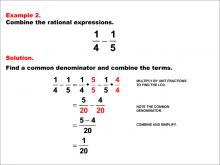
|
Math Example--Rational Concepts--Rational Expressions: Example 2 | Math Example--Rational Concepts--Rational Expressions: Example 2TopicRational Expressions DescriptionThis example illustrates how to combine the rational expressions 1/4 - 1/5. The solution involves finding a common denominator, which is 20, and then subtracting the fractions to get 1/20. We multiply each fraction by the appropriate factor to create equivalent fractions with the common denominator: (1 * 5/5) - (1 * 4/4) = 5/20 - 4/20. Then, we subtract the numerators while keeping the common denominator: (5 - 4)/20 = 1/20. |
Rational Expressions |
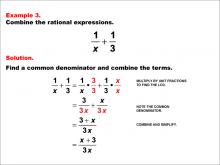
|
Math Example--Rational Concepts--Rational Expressions: Example 3 | Math Example--Rational Concepts--Rational Expressions: Example 3TopicRational Expressions DescriptionThis example demonstrates how to combine the rational expressions 1/x + 1/3. The solution involves finding a common denominator, which is 3x, and then adding the fractions to get (x + 3)/3x. We multiply each fraction by the appropriate factor to create equivalent fractions with the common denominator: (1 * 3/3) + (1 * x/x) = 3/(3x) + x/(3x). Then, we add the numerators while keeping the common denominator: (3 + x)/(3x) = (x + 3)/(3x). |
Rational Expressions |
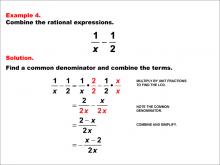
|
Math Example--Rational Concepts--Rational Expressions: Example 4 | Math Example--Rational Concepts--Rational Expressions: Example 4TopicRational Expressions DescriptionThis example illustrates how to combine the rational expressions 1/x - 1/2. The solution involves finding a common denominator, which is 2x, and then subtracting the fractions to get (x - 2)/2x. We multiply each fraction by the appropriate factor to create equivalent fractions with the common denominator: (1 * 2/2) - (1 * x/x) = 2/(2x) - x/(2x). Then, we subtract the numerators while keeping the common denominator: (2 - x)/(2x) = (x - 2)/(2x). |
Rational Expressions |
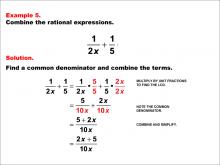
|
Math Example--Rational Concepts--Rational Expressions: Example 5 | Math Example--Rational Concepts--Rational Expressions: Example 5TopicRational Expressions DescriptionThis example demonstrates how to combine the rational expressions 1/(2x) + 1/5. The solution involves finding a common denominator, which is 10x, and then adding the fractions to get (2x + 5)/(10x). We multiply each fraction by the appropriate unit fraction to create equivalent fractions with the common denominator: (1 * 5)/(2x * 5) + (1 * 2x)/(5 * 2x) = 5/(10x) + 2x/(10x). Then, we add the numerators while keeping the common denominator: (5 + 2x)/(10x). |
Rational Expressions |
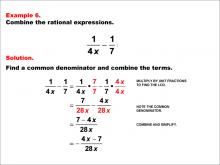
|
Math Example--Rational Concepts--Rational Expressions: Example 6 | Math Example--Rational Concepts--Rational Expressions: Example 6TopicRational Expressions DescriptionThis example illustrates how to combine the rational expressions 1/(4x) - 1/7. The solution involves finding a common denominator, which is 28x, and then subtracting the fractions to get (7 - 4x)/(28x), which simplifies to (4x - 7)/(28x). We multiply each fraction by the appropriate unit fraction to create equivalent fractions with the common denominator: (1 * 7)/(4x * 7) - (1 * 4x)/(7 * 4x) = 7/(28x) - 4x/(28x). Then, we subtract the numerators while keeping the common denominator: (7 - 4x)/(28x). |
Rational Expressions |
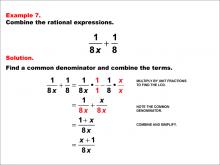
|
Math Example--Rational Concepts--Rational Expressions: Example 7 | Math Example--Rational Concepts--Rational Expressions: Example 7TopicRational Expressions DescriptionThis example demonstrates how to combine the rational expressions 1/(8x) + 1/8. The solution involves finding a common denominator, which is 8x, and then adding the fractions to get (x + 1)/(8x). We multiply each fraction by the appropriate unit fraction to create equivalent fractions with the common denominator: (1 * x)/(8x * x) + (1 * x)/(8 * x) = 1/(8x) + x/(8x). Then, we add the numerators while keeping the common denominator: (1 + x)/(8x). |
Rational Expressions |